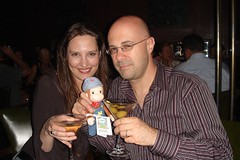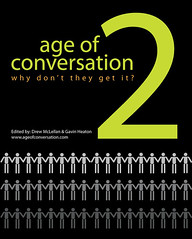 When Drew McLellan and I pulled together the first The Age of Conversation
When Drew McLellan and I pulled together the first The Age of Conversation book with 100 of the world’s leading bloggers, social media was still a rough and ready frontier. Two more editions
and three years later, many of us are still having the same conversations – partly because more businesses and more people are beginning to see value in the space, but also because innovation is like a spiral, folding back on itself in ever more complex ways.
With this in mind, I thought I’d publish here, my article from the first book – the Promiscuous Idea. To me, it still feels as relevant as it did in 2007. If you haven’t got a copy, consider buying one. It’s a great primer – and all the profits (still) go to a great cause.
The Promiscuous Idea
We are living in a time of proliferation. Never before has the marketplace of ideas been so free, the barriers to entry so low and the willingness to collaborate so powerful. In moments, a concept can be explained, shared and tracked on a single blog — on the other side of the world, this idea can be modified, expanded upon and discussed. Seconds pass and more voices are heard — a version transmutes into new forms … being picked up as a podcast, a video, an older-style presentation deck. From a single creative impulse, a legion of additions, modifications and transmutations can spread in minutes, hours, days and weeks.
Even months later an idea can come full circle. Someone, somewhere can stumble upon a “stale” idea, investing it with new energy, new context and a new perspective and the cycle of proliferation begins again. What this means is that our ideas are constantly in a process of reinvention.
What links an idea and draws us to it is the “story”. And the power and gravitational pull of the story brings us back to it time and again. In the Age of Conversation, whether we are marketers, activists, educators, politicians, academics or citizens of the world, we are all becoming the connected storytellers of this new era. This presents new challenges but also significant
opportunities for brands, consumers and communities.
We are now dealing with a different type of story. Where once we had a beginning, middle and end, as readers and storytellers we can fall into a story at any point. We can link into the middle of a raging debate or witness the genesis of an idea that can change the world, and the narrative that we
are dealing with is no longer linear but multi-textual, layered, overlapping and promiscuous. The ideas and stories care not for their creator but freely leap from one mind to the next — sometimes appearing simultaneously across the globe — with storytellers tapping into a powerful worldwide zeitgeist.
The new art of conversation relies not on a sense of ownership but on a willing openness on the part of storytellers of all kinds. In fact, the jealous storyteller may well find that “their” ideas, brands, concepts or other “intellectual property” will laughingly thumb its nose at its creator and walk off, hand-in-hand with the idea-next-door. Whether we like it or not, our brands, ideas and
stories are no longer our own … they are out there promiscuously reinventing themselves word by word.


 Each author will be able to submit one 400 word article. To make sure the content is varied and to avoid repetition, we've created 10 section topics. Each author will select one topic and then direct the content of their submission accordingly. There will be a maximum of 30 authors per section.
Each author will be able to submit one 400 word article. To make sure the content is varied and to avoid repetition, we've created 10 section topics. Each author will select one topic and then direct the content of their submission accordingly. There will be a maximum of 30 authors per section.